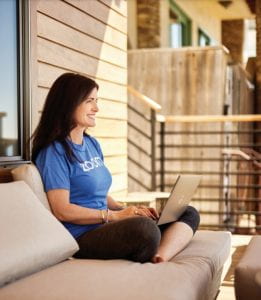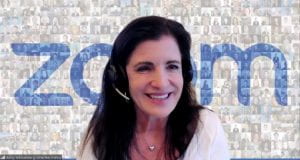Kelly Steckelberg (MPA ’91) has always looked for opportunities to learn something new. Four years ago, she joined a company called Zoom. Then the pandemic hit. Here’s how Zoom’s CFO managed the company’s whirlwind year.

Kelly Steckelberg works remotely from her patio. Photo by Dustin Snipes.
The world changed earlier for Kelly Steckelberg than it did for most of us. As CFO of Zoom, the Silicon Valley video communications giant, she and other company leaders had been watching the approaching coronavirus storm and anticipating the disturbance it might unleash.
For Zoom, it would be a deluge. Steckelberg’s last day in the office was March 4, 2020. The office had closed to workers the day before, and Zoom’s leaders focused on making sure their employees felt safe and supported. Then they went home.
“We had the luxury that we all lived in the technology,” Steckelberg explains. “We had to adjust to being remote, but the technology itself obviously was something we were all using every day for every meeting. Really, we were watching very closely what was happening. Even watching, I don’t think we could have predicted how quickly it accelerated. On March 15 everything changed overnight for Zoom.”
As many Americans started to work from home, Zoom was on its way to becoming a household name. The company went from an average 10 million daily meeting participants in December 2019 to 300 million in April 2020.
Days blurred as everyone tried “to make sure that all of our customers and prospects who had a need for Zoom had access to it,” she says. It was an exhausting pace, and Steckelberg still had to juggle her many duties at Zoom. She is responsible for the chief accounting officer f unction, financial planning and analysis, budgeting and forecasting, procurement, investor relations, tax and treasury, corporate development, and Zoom’s real estate portfolio, including its offices.
Just as dramatic as the growth in their customer base was the expansion of their head count. Prepandemic Zoom had about 2,200 employees; that number has more than doubled to 5,000. “The brand awareness for Zoom and the flexibility of hiring has made it easy,” Steckelberg says. “Of course, it comes with very unique challenges to double your workforce in a completely remote environment, but we’ve done it.”
While she has been locked down like the rest of us, she has had to put aside her wanderlust. Her tally stands at 60 countries — but over the last year and a half, the farthest she’s gone is to the nearby beach.
Steckelberg is used to moving around. Her family moved often during her childhood, finally settling in Harper, Texas, a small Hill Country town where she had 15 students in her graduating class. There were only two electives offered at her high school: shop or home economics.

Kelly Steckelberg meets with current MPA students via Zoom while sitting in a hotel lobby in San Antonio during the fall MPA Distinguished Speaker Lyceum.
Arriving at the Forty Acres, she switched majors from fashion merchandising to accounting (her father was a CPA). She took advantage of the five-year MPA program as a student in the program’s early days. “It seemed like a great opportunity to get my master’s done all at one time,” she says. The comprehensive curriculum also prepared her for the CPA exam and gave her a leg up on the competition.
More than that, she says many of the analytical skills she learned have stayed with her. “It’s a lot more about how you think through problems, how you problem solve, and how do you help make decisions. McCombs helped me do well.”
At each stage in her career, she has looked for opportunities that would broaden her skill set. Her first job was with KPMG, where she gained exposure to different industries traveling to Bay Area clients. She started in audit and then took an opportunity in tax to learn something new. She left KPMG and went to PeopleSoft, where after a year, the company offered her a chance to move to Amsterdam.
At the same time, she set a goal to become a public company CFO. “That started to help me target the types of roles I was going for,” she says. She landed at WebEx as the corporate controller, and although she thought one day she might have a shot at becoming CFO, the company was acquired by Cisco. New doors, however, opened.
From there she became CFO of the dating site Zoosk, her first experience working in a private company, a start-up, and a consumer web company. She moved into the COO role and learned the operations side of the business. A long sought-after goal of any CFO – taking a company public – ended with disappointment when Zoosk wasn’t able to adjust its business model quickly enough and called off its IPO. When the founders exited the company, the board asked Steckelberg to take over as CEO. “It was one of the hardest jobs I’ve ever done, but it was amazing and rewarding in the end. When you start to see your strategy come together, it’s really rewarding.”
After Zoosk, she expected to take a break, but within two days of updating her LinkedIn, she heard from a former colleague with a message that would change her life. A colleague from WebEx, Eric Yuan, the founder and CEO of Zoom, sent her a message. “I think he wrote something like, ‘It would be a dream if we could work together again.’”
Steckelberg was drawn by the opportunity to work with Yuan again and the chance to achieve her goal of helping take a company public. When Zoom went public in 2019, it was a career highlight, she says. Of course, no one knew Zoom would command the world stage by spring 2020.
Yuan is pleased he brought her on board. “Kelly is a brilliant leader and someone who makes Zoom a better place. She has an adept ability to make tough decisions and lead by example. We are so lucky to have her on our leadership team.”
Over the past year, she says, the company has stayed focused on two goals: making sure their platform was stable and available to their customers, and supporting a boom in employees. At the same time, they have strived to make decisions that would be sustainable post-pandemic. They had to continue adding sales reps to serve their customers and engineers to keep developing their platform. It was a difficult balance to strike.
Now as workers begin coming back to the office, how will that impact the company’s fortunes? Steckelberg says she doesn’t expect us to stop Zooming. “Zoom has become embedded in all aspects of our lives. It’s in our work life. It’s in our children’s learning. It’s in our social life now,” she says. “As we move toward the time where we can all move around the world again more safely, we’re going to want to leverage Zoom for the aspects that make our lives the most convenient. The future of work is not ever going to look the way it did before.”
Zoom is positioning itself for the post-pandemic world by building out some features that the company hopes will continue to showcase its value. One of them is the Smart Gallery, an innovation meant to improve the experience for a mixed environment where some employees are in a conference room and others are remote. Another new development is Zoom Apps: in-meeting applications by third-party developers to improve the meeting experience, such as integration with a service like Dropbox.
“Over time, what you’re going to see is Zoom continuing to evolve to be a platform where you spend your workday,” she says. “It’s not just where you come together to meet, but it’s also where you do your work and, especially, continue to collaborate with colleagues or with friends and family.”
After a year like no other, Steckelberg says she is proud of what the company has accomplished. “I can’t imagine not having been here with the amazing team and gone through this. It’s a lifelong experience that I’ll never forget.”
The original version of this article was written by Todd Savage and appeared in the summer 2021 edition of McCombs Magazine. His article is reproduced here, edited for length and clarity.

Leave a Reply